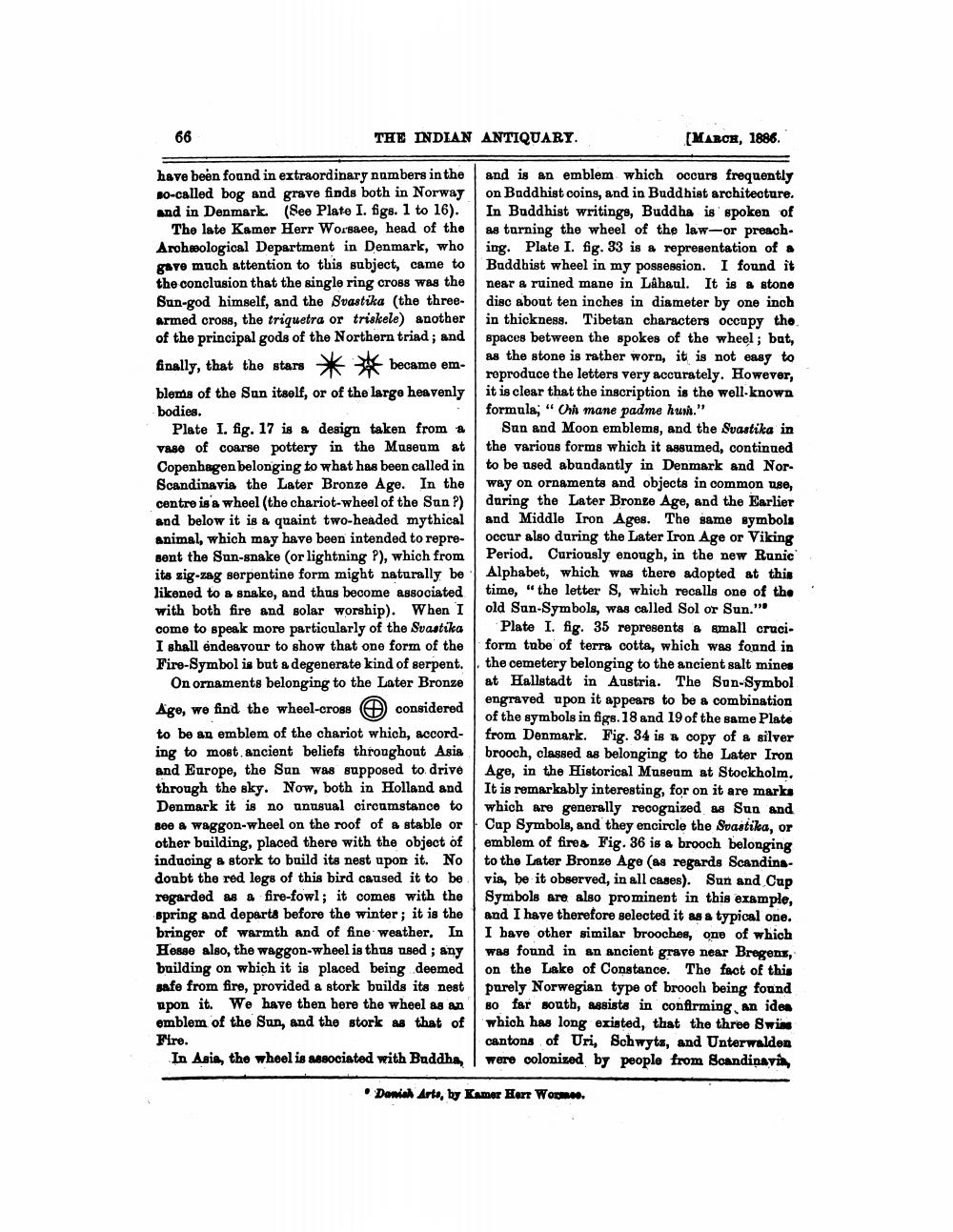________________
66
THE INDIAN ANTIQUARY.
have been found in extraordinary numbers in the so-called bog and grave finds both in Norway and in Denmark. (See Plate I. figs. 1 to 16).
The late Kamer Herr Worsaee, head of the Archeological Department in Denmark, who gave much attention to this subject, came to the conclusion that the single ring cross was the Sun-god himself, and the Svastika (the threearmed cross, the triquetra or triskele) another of the principal gods of the Northern triad; and finally, that the stars became emblems of the Sun itself, or of the large heavenly bodies.
Plate I. fig. 17 is a design taken from a vase of coarse pottery in the Museum at Copenhagen belonging to what has been called in Scandinavia the Later Bronze Age. In the centre is a wheel (the chariot-wheel of the Sun ?) and below it is a quaint two-headed mythical animal, which may have been intended to represent the Sun-snake (or lightning ?), which from its zig-zag serpentine form might naturally be likened to a snake, and thus become associated with both fire and solar worship). When I come to speak more particularly of the Svastika I shall endeavour to show that one form of the Fire-Symbol is but a degenerate kind of serpent.
On ornaments belonging to the Later Bronze Age, we find the wheel-cross considered to be an emblem of the chariot which, according to most ancient beliefs throughout Asia and Europe, the Sun was supposed to drive through the sky. Now, both in Holland and Denmark it is no unusual circumstance to see a waggon-wheel on the roof of a stable or other building, placed there with the object of inducing a stork to build its nest upon it. No doubt the red legs of this bird caused it to be regarded as a fire-fowl; it comes with the spring and departs before the winter; it is the bringer of warmth and of fine weather. In Hesse also, the waggon-wheel is thus used; any building on which it is placed being deemed safe from fire, provided a stork builds its nest upon it. We have then here the wheel as an emblem of the Sun, and the stork as that of Fire.
In Asia, the wheel is associated with Buddha,
[MARCH, 1886.
and is an emblem which occurs frequently on Buddhist coins, and in Buddhist architecture. In Buddhist writings, Buddha is spoken of as turning the wheel of the law-or preaching. Plate I. fig. 33 is a representation of a Buddhist wheel in my possession. I found it near a ruined mane in Lâhaul. It is a stone disc about ten inches in diameter by one inch in thickness. Tibetan characters occupy the. spaces between the spokes of the wheel; but, as the stone is rather worn, it is not easy to reproduce the letters very accurately. However, it is clear that the inscription is the well-known formula; "Oni mane padme hush."
Sun and Moon emblems, and the Svastika in the various forms which it assumed, continued to be used abundantly in Denmark and Norway on ornaments and objects in common use, during the Later Bronze Age, and the Earlier and Middle Iron Ages. The same symbols occur also during the Later Iron Age or Viking Period. Curiously enough, in the new Runic Alphabet, which was there adopted at this time, "the letter S, which recalls one of the old Sun-Symbols, was called Sol or Sun."""
Plate I. fig. 35 represents a small cruciform tube of terra cotta, which was found in the cemetery belonging to the ancient salt mines at Hallstadt in Austria. The Sun-Symbol. engraved upon it appears to be a combination of the symbols in figs. 18 and 19 of the same Plate from Denmark. Fig. 34 is a copy of a silver brooch, classed as belonging to the Later Iron Age, in the Historical Museum at Stockholm, It is remarkably interesting, for on it are marks which are generally recognized as Sun and Cup Symbols, and they encircle the Svastika, or emblem of firea Fig. 36 is a brooch belonging to the Later Bronze Age (as regards Scandina via, be it observed, in all cases). Sun and Cup Symbols are also prominent in this example, and I have therefore selected it as a typical one. I have other similar brooches, one of which was found in an ancient grave near Bregenz, on the Lake of Constance. The fact of this purely Norwegian type of brooch being found so far south, assists in confirming, an idea which has long existed, that the three Swiss cantons of Uri, Schwyta, and Unterwalden were colonized by people from Scandinavia,
• Danish Arts, by Kamer Herr Wormee.




